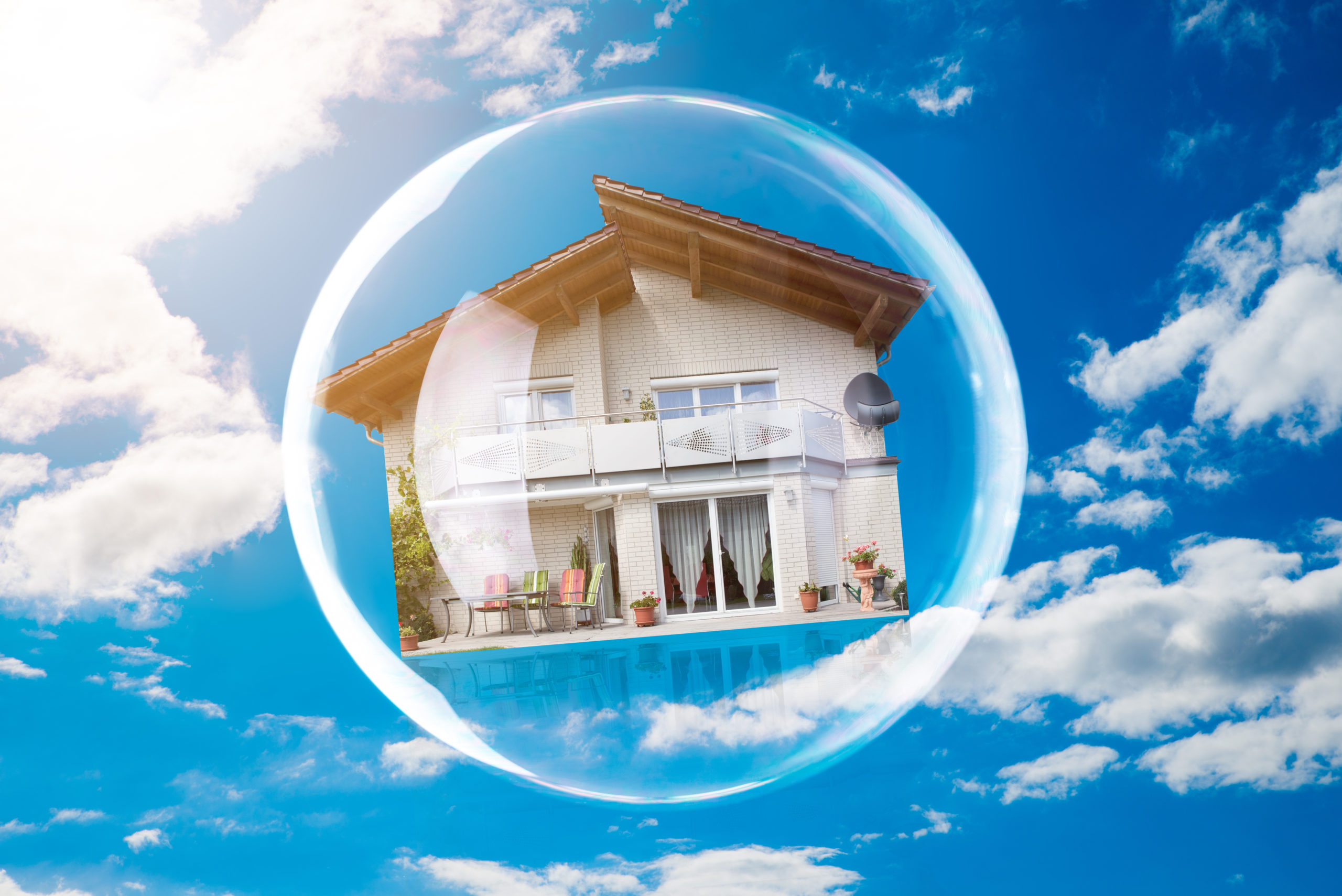As the economy picks up again and we begin to move into a post-pandemic environment, real estate professionals around the country are asking if we may be in a housing bubble and, if so, when will it burst?
Both Jeff Greene, a billionaire real estate investor, and Jamie Dimon, CEO of JPMorgan Chase, say yes. However, Dimon says he’s not worried about a crash like the one we had in 2008-2009.
Almost everyone else says today’s real estate market is not a bubble. So what is it?
The Factors Driving the Real Estate Market Today
When we analyze the real estate market in 2021, we’ve got to keep in mind that we are following an unusual year of very unusual activity. The COVID-19 pandemic and associated lockdowns, social distancing guidelines, and public health concerns brought the real estate market to a near halt. New construction was hampered, buying and selling were stilted, and lenders tightened their credit standards. It was an unusual year.
 What happened in 2008 was a weak labor market drove foreclosures higher while banks and other lenders loosened their credit standards. Last year’s pandemic brought with it mortgage forbearances so that income earners out of work wouldn’t lose their homes. Different environment.
What happened in 2008 was a weak labor market drove foreclosures higher while banks and other lenders loosened their credit standards. Last year’s pandemic brought with it mortgage forbearances so that income earners out of work wouldn’t lose their homes. Different environment.
Another way the pandemic has impacted housing is that it caused a massive movement from urban centers to the suburbs. This is interesting because this massive move was spurred by an increase in remote work. People living close to urban centers didn’t need to be near their offices anymore, so they moved out of the city into the suburbs where they could work remotely and more at ease. This drove up demand for housing and increased housing prices since the pandemic slowed down new construction.
This is basic economics. Lower supply and higher demand cause prices to go up. And that’s what we’re seeing in 2021.
Another thing we’re seeing is an increase in homeowner equity. People who bought their homes ten years ago have seen their home’s value increase. Now they have equity, which serves as a cushion in economic downturns. It also means they are in no hurry to sell, but if they do sell, they can put that equity toward a down payment in a more valuable home.
What Causes a Housing Bubble?
Housing bubbles are generally caused by a strong economy giving people more disposable income, which they put into buying new homes. Coupled with low-interest rates and loose credit standards, the market creates opportunities for risky behaviors and new mortgage products. As a result, there is more speculative activity as investors try to invest in the next big thing or predict where the market is headed.
Housing bubbles are also often accompanied by mass moving. A lot of people migrate from one location to another at the same time.
Looking at today’s real estate climate, there are some similarities between the housing bubble of 2008 and 2009 and the 2021 housing market. However, those similarities fall short of causing worry when compared with the differences in the two markets. What are those differences?
In 2008 and 2009, there was a lot of speculation and risky behavior in the financial markets. We don’t see that today. New mortgage products are not rolling off the lending shelves every day with sophisticated sales techniques to push them.
While demand was high, as it was then, it’s coupled with low supply due to the slowdown in construction activity last year. The low supply of housing today was not created by natural market conditions. It’s artificial. As the economy picks up again, developers will begin building again and supply will catch up to demand. It may take two to five years, but it will happen. As it does, prices will stabilize.
Housing prices have gone crazy, but that’s due to the aforementioned conditions of high demand and low supply with stable interest rates. We expect to see this settle down.
One very important way today’s housing market is different is that mortgage companies and lenders have tightened their credit standards. They aren’t loaning money to just anyone. In 2008 and 2009, lenders were creating new credit products and selling them to people who couldn’t afford them. That could easily occur following a year like last year where home equity increased and remote work drove up demand for housing in the suburbs. But it didn’t. Instead, lenders tightened their credit standards, which has served to strengthen the real estate market.
Housing bubbles are caused by a lot of activity in the market due to speculation and risky behavior. We’re not seeing that in 2021. We’re seeing people shifting their priorities and adapting to a new reality, which is leading to a spike in housing demand.
Low Supply Plus High Demand Does Not Equal Housing Bubble
 The biggest factor impacting the housing market today is low supply. Builders simply haven’t been able to keep up with demand because, first, it wasn’t expected. Secondly, forced social distancing guidelines and business lockdowns, especially in places like Pennsylvania and New York, meant that new construction came to a halt. We see it picking up again. As the Biden Administration continues to push for vaccines with the hope of vaccinating 70 percent of the population against COVID-19, we should see the economy open up more.
The biggest factor impacting the housing market today is low supply. Builders simply haven’t been able to keep up with demand because, first, it wasn’t expected. Secondly, forced social distancing guidelines and business lockdowns, especially in places like Pennsylvania and New York, meant that new construction came to a halt. We see it picking up again. As the Biden Administration continues to push for vaccines with the hope of vaccinating 70 percent of the population against COVID-19, we should see the economy open up more.
Demand will likely continue to climb, although at a lower rate, as supply struggles to catch Interest rates will likely remain stable. The housing market will remain healthy for the foreseeable future. Older Americans are continuing to downsize as they age and move into senior housing while younger Americans are showing signs of entering the homeownership market.
We should see a gradual shift in homeownership over time with younger Americans buying from older Americans. New construction will cater to the needs of younger Americans and remote workers with greater emphasis on suburbs and rural communities. When supply matches demand in the housing market, we’ll have reached a point of equilibrium that should keep the real estate market stable for a few more years.


